My adapters arrived in the mail, allowing me to connect the ADCMP606 pulse generator to scope inputs with no intervening cable, so I decided to test the scopes I had hanging around the lab. The difference between low-end and high-end scopes quickly became apparent. First up, the Tektronix TDS754D, hacked into a 1 GHz TDS784D. At full bandwidth, it shows a 395 ps rise time. I still don't know exactly how fast the pulse edge is, so this result is a little suspect.
 In all cases, I used Tektronix's recommended BW = 0.45/t formula for estimating the scope's bandwidth from rise time measurements. In this case, we get a bandwidth of 1.14 GHz. This is plausible for a 1 GHz scope.
In all cases, I used Tektronix's recommended BW = 0.45/t formula for estimating the scope's bandwidth from rise time measurements. In this case, we get a bandwidth of 1.14 GHz. This is plausible for a 1 GHz scope.
Next, I turned on the 250 MHz LPF. Note that the scope shows a decently Gaussian response, like you would expect from an actual 250 MHz scope - the results for the cheaper units below are vastly different. In this case, the rise time is 1.5 ns, implying a bandwidth of 300 MHz.
 Finally, I enabled the 20 MHz limiting filter and measured a 17.5 ns rise time, equating to a 26 MHz bandwidth using the 0.45 constant. Note that using the 0.35 constant recommend for older scopes, this equates to exactly 20 MHz. Also note the Gaussian-looking edges on the step: again, this is doing a good imitation of a slow scope, unlike the less expensive scopes explored below.
Finally, I enabled the 20 MHz limiting filter and measured a 17.5 ns rise time, equating to a 26 MHz bandwidth using the 0.45 constant. Note that using the 0.35 constant recommend for older scopes, this equates to exactly 20 MHz. Also note the Gaussian-looking edges on the step: again, this is doing a good imitation of a slow scope, unlike the less expensive scopes explored below.
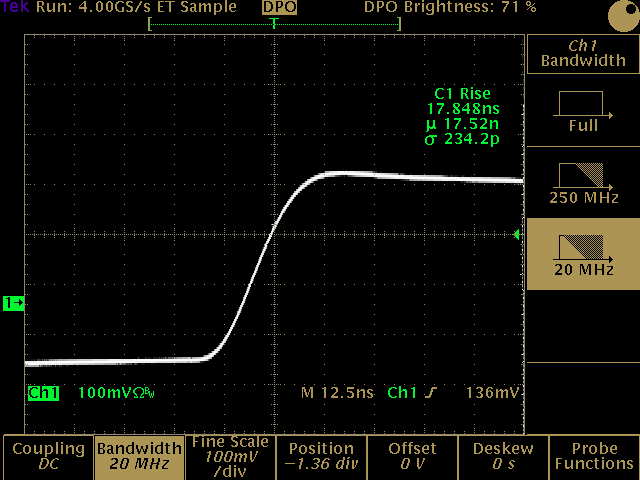
Rigol DS2302A
Next up is a Rigol "DS2302A" 300 MHz scope. It's actually a hacked 70 MHz DS2072A. At full bandwidth, the rise time comes in at 1.06 ns, which means a 424 MHz bandwidth.
 Turning on the 100 MHz filter, the rise time drops to 3.46 ns, and the estimated bandwidth is 101 MHz. Here, I've used the 0.35/t bandwidth approximation since it is valid for an RC response. The shape of this step is very interesting, kinda lousy, and representative of all three inexpensive scopes I tested. Notice how the step resembles an exponential RC ramp instead of a Gaussian step? Can you guess how the low-pass filter is implemented in this scope?
Turning on the 100 MHz filter, the rise time drops to 3.46 ns, and the estimated bandwidth is 101 MHz. Here, I've used the 0.35/t bandwidth approximation since it is valid for an RC response. The shape of this step is very interesting, kinda lousy, and representative of all three inexpensive scopes I tested. Notice how the step resembles an exponential RC ramp instead of a Gaussian step? Can you guess how the low-pass filter is implemented in this scope?
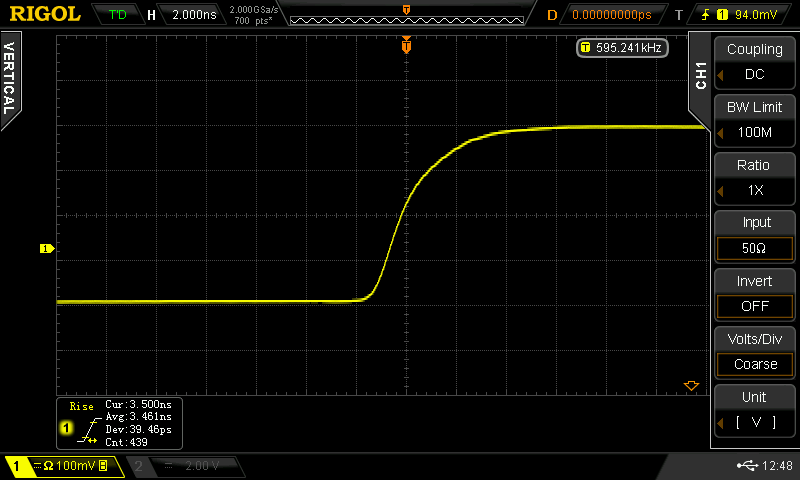
Continuing with the 20 MHz filter on this scope, we get a 14.6 ns rise time and 24 MHz bandwidth, again using the 0.35 constant. The use of an RC filter as a bandwidth limiting element is even more apparent here.
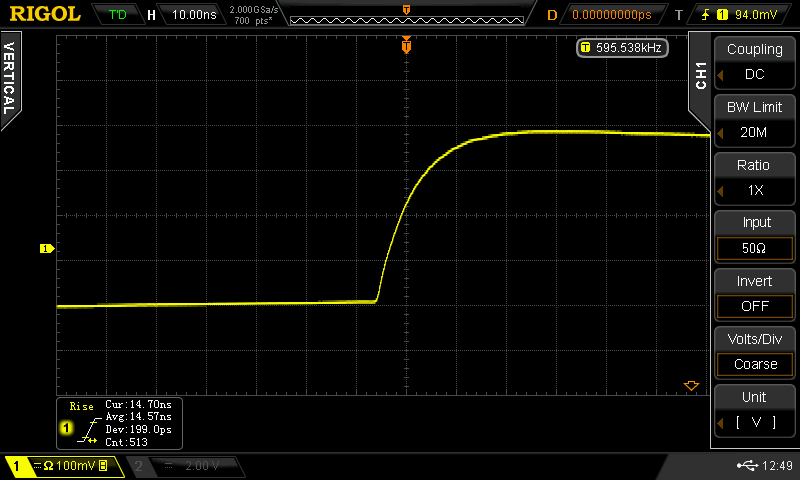
RIgol DS1104Z
Another "upgraded" Rigol, this time from a DS1054Z to a 100 MHz DS1104Z. At full bandwidth, we measure a 2.7 ns rise time, and 130 MHz bandwidth (0.35/t). Note that the pulse already looks a little RC-ish. It makes you wonder about the anti-aliasing filter.
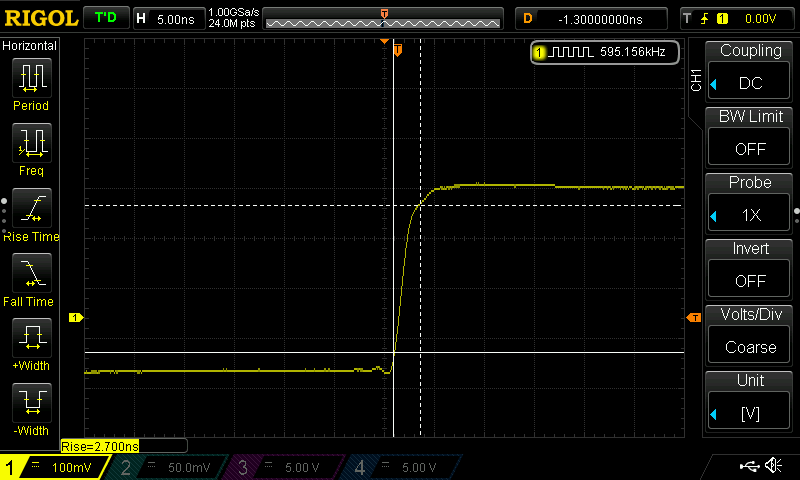 Adding in the 20 MHz bandwidth limit brings on the full RC pulse shape. It also increases the rise time to 13.4 ns, and decreases the bandwidth to 26 MHz (0.35/t).
Adding in the 20 MHz bandwidth limit brings on the full RC pulse shape. It also increases the rise time to 13.4 ns, and decreases the bandwidth to 26 MHz (0.35/t).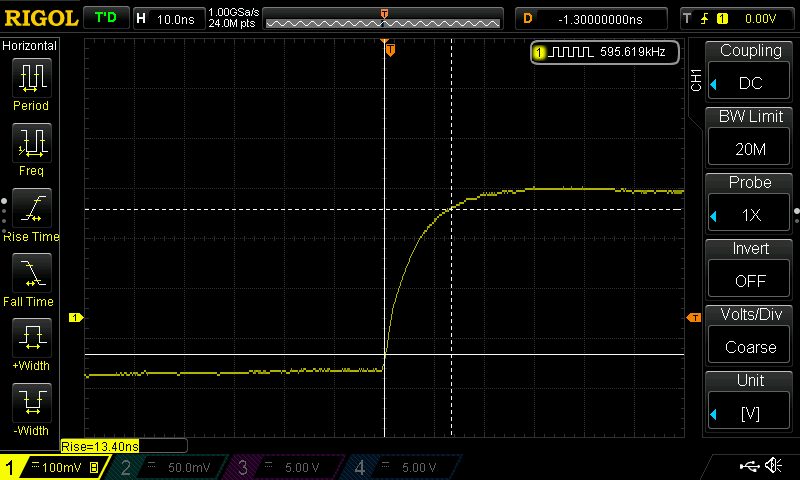
OWON SDS7102
Don't buy this scope. The Rigol DS1054Z is an infinitely better value. On the OWON I have, the rotary encoders have become almost unusable - half the time, they move backwards. The only reason I keep this scope around is because it works on batteries, so it's useful for poking around in the car without dragging an inverter into the garage.
The SDS7102 is billed as a 100 MHz scope, although the 1.96 ns rise time implies more like 179 MHz (0.35/t). This may be the scope's only other redeeming feature.
 Turning on the 20 MHz limiter, we measure 14.5 ns, meaning 24 MHz (0.35/t). As with the Rigol's, this scope uses a very simple bandwidth limiting filter. You'd ideally see the same Gaussian-shape edge just with a longer rise time.
Turning on the 20 MHz limiter, we measure 14.5 ns, meaning 24 MHz (0.35/t). As with the Rigol's, this scope uses a very simple bandwidth limiting filter. You'd ideally see the same Gaussian-shape edge just with a longer rise time.
Maybe nobody uses the bandwidth limit feature on their scope?

GoldStar OS-9020G
Last up, we have an analog scope, just for kicks. The OS-9020G boasts a 20 MHz bandwidth, and no automated measurement capability at all. I added the lines below, manually estimating a 12 ns rise time, which would imply a 37.5 MHz bandwidth using the 0.45 constant. This is certainly a scope where the 0.35 constant should be used, resulting in an estimate of 29 MHz.To get this image, I had to enable the 10x zoom, which the front panel warns is uncalibrated when used with the 200 ns/div timebase setting. So, the result shown here might be something close to 20 ns/div. Then again, the scope hasn't been calibrated since it left the factory around 1998.
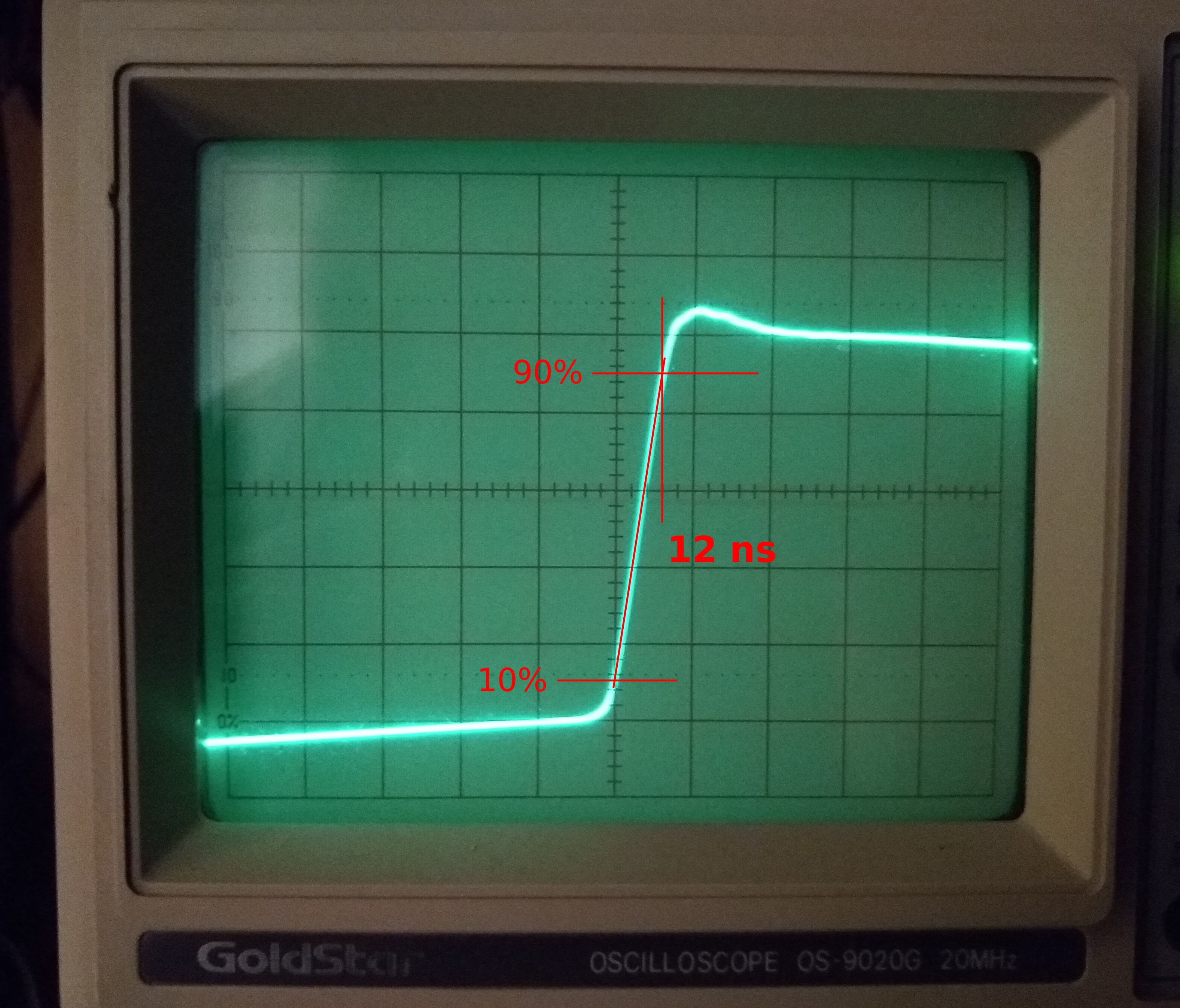
EDIT 20190104: It turns out that the 0.35/t bandwidth estimate is equally valid for 10/90% rise-times on RC responses (the constant for Gaussian shapes is 0.34). I modified the text accordingly.
 Ted Yapo
Ted Yapo
Discussions
Become a Hackaday.io Member
Create an account to leave a comment. Already have an account? Log In.
Thanks for the comparisons !
Are you sure? yes | no
No problem. I'm ashamed to admit I have two others I didn't test. One has a broken timebase, so I guess there's only one more.
Are you sure? yes | no
At least you made your point. Bandwidth limitation with a capacitor sucks.
Are you sure? yes | no
@Ted Yapo thanks for a great example of the differences between higher and lower cost 'scopes. I'm not quite sure what the impact of the RC (rather than gaussian) ramps would be on my work (mainly not being able to accurately time pulse rises?) but it's great to see several 'scopes put through the same signal input and compared. I am about to buy my second 'scope - the first being one those "solder it yourself" DSO138 kits by jyetech. So you can appreciate that a proper 'scope will be a big step up in performance for me.
Given that I'll be mainly working on uCs like ATMEGA/ATtiny, samd21 and esp32, am I overdoing it with anything more than a DS1054Z?
Are you sure? yes | no
You might never see any ill effect from the BW filter on the inexpensive scopes. You'd mostly use this feature for cleaning up noisy signals, and for that, the filters might be good enough. For me, it's more of an indication of where corners get cut to make an inexpensive scope.
The DS1054Z is a solid value for the money. If I were buying again, though, I'd consider one of the models with logic analyzer channels. The downside is that they're considerably more expensive. But just as a scope, it's pretty solid. Fully "enhanced", it's 100 MHz. If you're looking at digital signals up to 20 MHz or so, this may be all you'll ever need.
Are you sure? yes | no
Thanks so much Ted, it's always much better to take advice and experience from someone you feel like you know! Just a quick one - does the benefit of having the logic analyzer connected to the same device/ screen with the analog signals make it worth the extra money and loss of 2x analog channels on the cheaper LA versions? Or is a separate logic analyzer and a 4ch scope about the same capability (BW aside)?
Are you sure? yes | no
@Simon Merrett Those are good questions. There is definitely a benefit to having both instruments integrated - for instance, you can have a look at the analog features of signals while debugging logic issues. Check out these articles:
https://community.keysight.com/community/keysight-blogs/oscilloscopes/blog/2016/09/01/why-would-you-want-a-mixed-signal-oscilloscope
http://oscopes.info/background/5-digital-debugging-better-using-a-mixed-signal-oscilloscope-or-a-logic-analyser
https://www.electronicdesign.com/test-amp-measurement/what-s-difference-between-mixed-signal-oscilloscope-and-logic-analyzer
I think all of the DS1000Z Rigols have 4 analog channels - there's no need to choose.
Also check out the MSO5000's if your budget will allow it.
https://hackaday.com/2018/12/19/rigol-mso5000-hacked-features-unlocked/
Are you sure? yes | no
@Ted Yapo awesome - this is really helpful. I have read those articles and can see the benefits, albeit on higher speed systems than I'm used to working with. Regarding the DS1000Z series, the DS1054Z now comes with bus decoding for RS232, I2C, SPI. Given that these are the protocols I'm most likely to work with, is there a diminished case for the LA feature? I'm thinking USB is the only one missing that would be routinely useful but perhaps I'm missing something?
Also, there's an interesting note against the MSO ready DS1074Z and DS1104Z plus models: Please note... The number of available analogue channels is reduced by 1 for every block of 8 digital channels in use. For example, if 9 to 16 digital channels are in use, the number of available analogue channels is 2.
Are you sure? yes | no
@Simon Merrett I have used the I2C, SPI and async serial decoders on the DS1054Z, and they do the job. You can probably get 90% of the utility of a cheap MSO with just the scope and a very inexpensive logic analyzer.
Are you sure? yes | no
@Ted Yapo once again, I value your help. I'll probably go for the DS1054Z and cheap LA with sigrok pulseview. It's not often that I talk my way into the cheaper piece of equipment so you can tell just how useful you have been!
Are you sure? yes | no